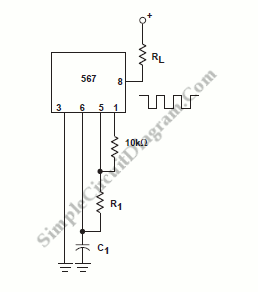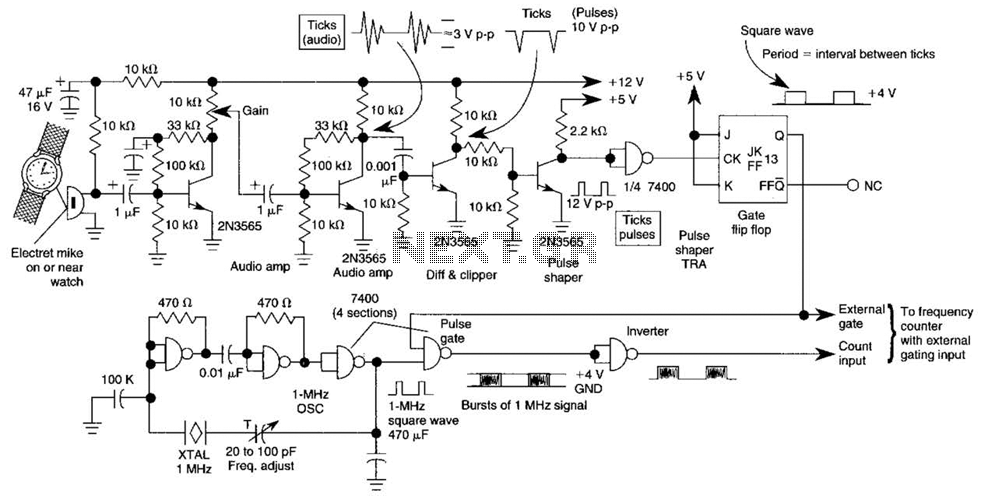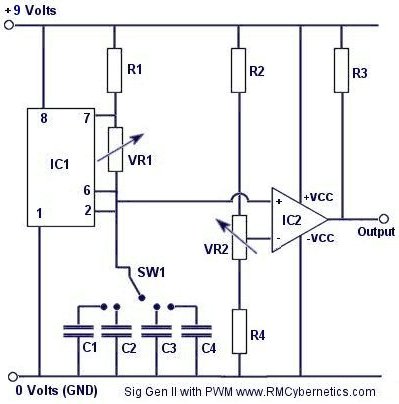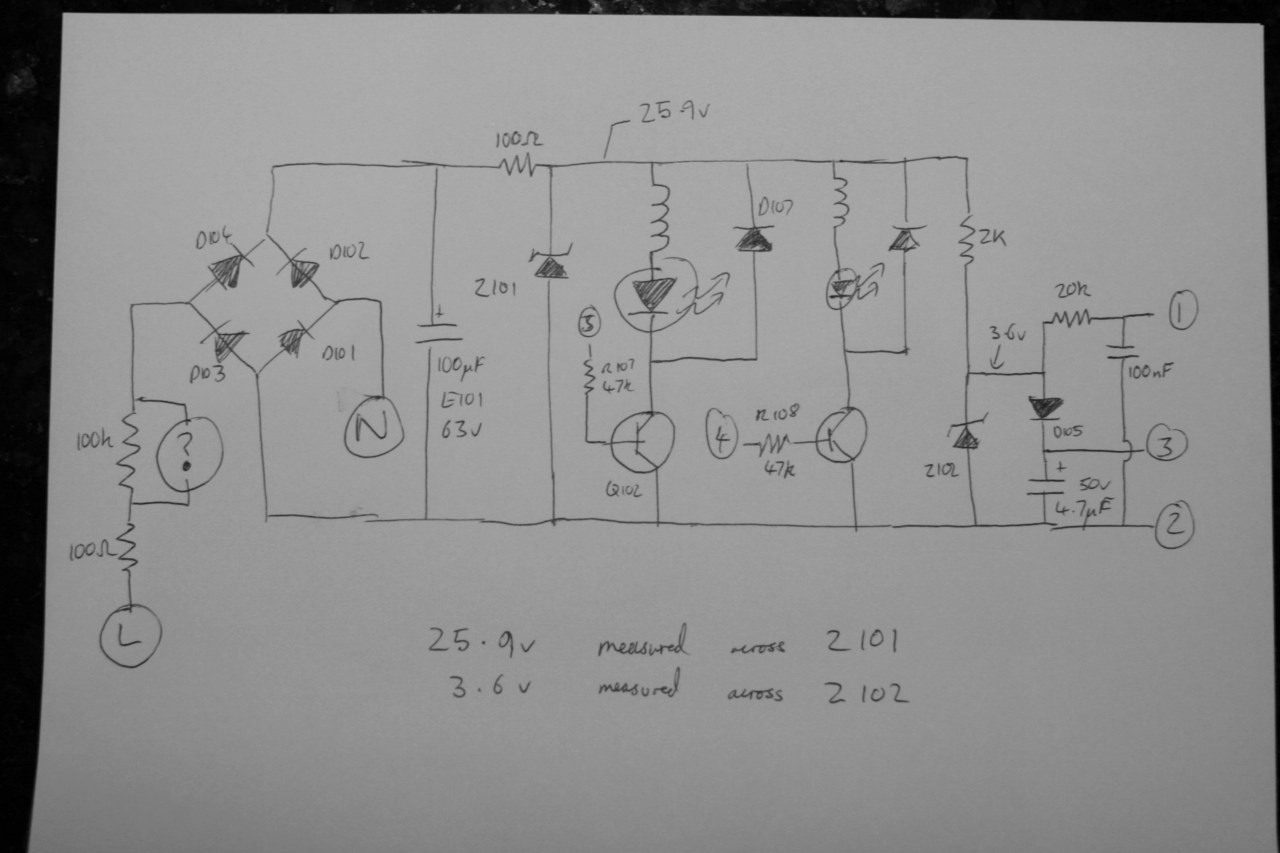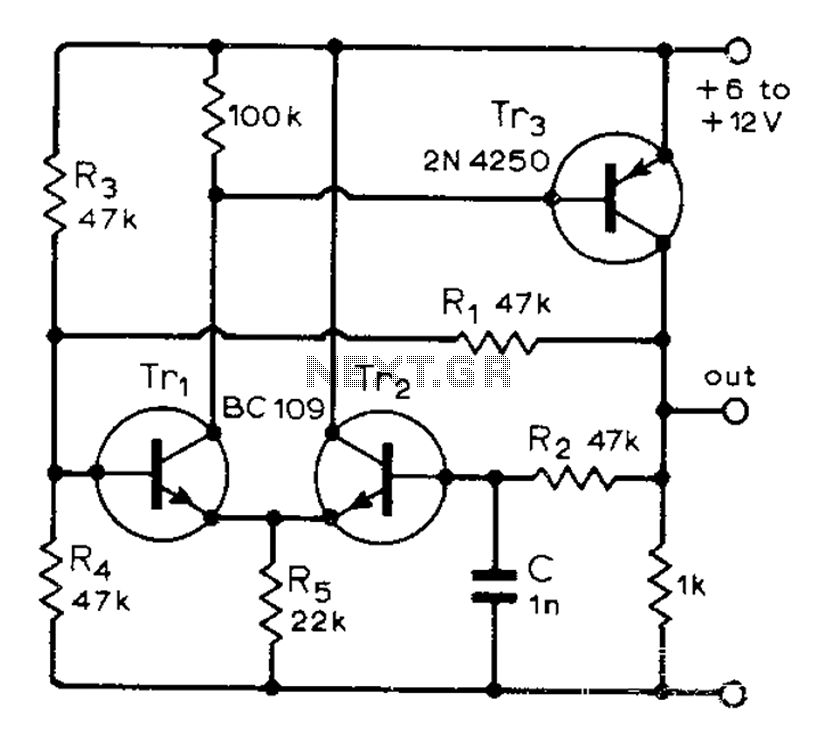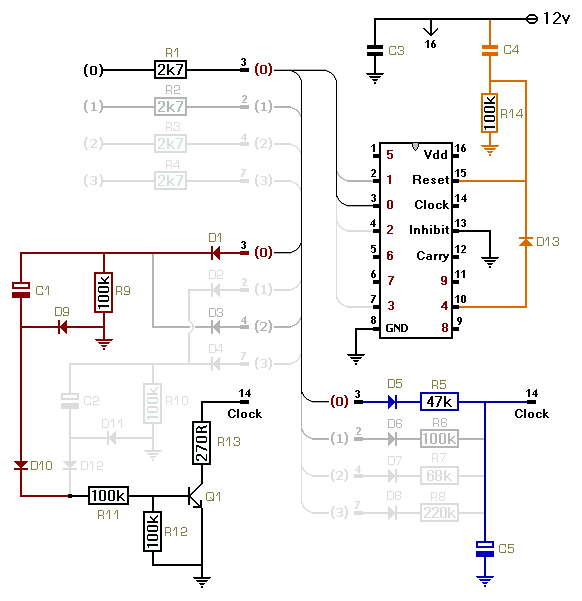
time pulse
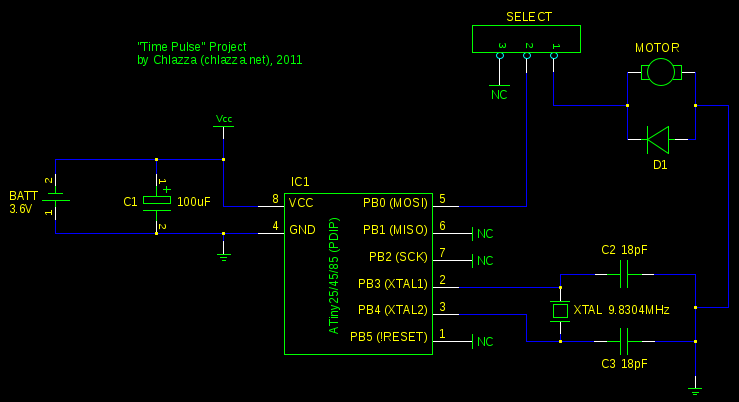
The concept was to illustrate the passage of time using tactile feedback instead of a conventional clock face, digits, or binary lights. A simple vibration motor emerged as an ideal choice, commonly used as force feedback actuators in video game controllers and as indicators in mobile phones and pagers. These components are widely recognized and readily available. However, it was noted that Digikey does not carry the desired item. Sparkfun offers a suitable motor for five dollars each, while All Electronics has a few options at competitive prices. It is advisable to consider salvaging parts from old cell phones or pagers before purchasing, especially given shipping costs for inexpensive motors. A 555 timer chip was initially contemplated to reduce costs, but a microcontroller was ultimately chosen for its ease in counting minutes, hours, and days without extensive analog configurations. A 555-based circuit would be viable for those only requiring a simple heartbeat pulse without additional timing complexities. The crystal frequency used is an unusual value, as the project was prototyped on a development board from a previous project that operated at 9600 bps, resulting in a frequency of 9,830,400 Hz. Adjustments to the microcontroller fuses were necessary to utilize the crystal, although the exact settings are not recalled. A diode is placed in parallel with the motor to mitigate back-EMF, as the motor coil acts as an inductor. This technique is commonly employed with larger motors and is deemed beneficial here as well. A 100 µF capacitor is also included on the power lines to smooth out noise generated by the motor and to provide quick power bursts when needed. A SELECT jumper was incorporated, initially intended to allow switching between an LED and the motor. The core functionality involves a faint pulse every second, a longer pulse each minute, a more pronounced pulse every hour, and a nearly one-second pulse at the change of day. Setting the time is straightforward: the device begins counting from zero upon connection to power, requiring the user to connect the power source precisely at midnight. The drift of the clock has not been tested, and it does not account for Daylight Savings Time, rendering it somewhat basic. A Motorola BR50 Lithium-Ion cell salvaged from a subpar mobile phone is used for power. The accompanying images show the battery charging after self-discharging to 0.16 volts, with wires in the device's screw terminal intended for temporary connection to a bench power supply.
The circuit design incorporates a microcontroller as the primary timing element, allowing for precise control over the timing intervals and pulse outputs. The microcontroller is programmed to generate specific pulse widths for the vibration motor, with the timing intervals defined by the internal clock derived from the attached crystal oscillator. The use of a diode in parallel with the motor is critical to protect the microcontroller from voltage spikes caused by the inductive load when the motor is deactivated. The 100 µF capacitor serves a dual purpose: it filters out voltage fluctuations that could affect the microcontroller's operation and provides immediate power to the motor during its activation, ensuring consistent performance.
The SELECT jumper functionality can be expanded to allow for future enhancements, such as integrating an LED for visual notifications alongside the tactile feedback. This flexibility in design supports potential upgrades or modifications based on user requirements. The system's simplicity, while limiting advanced features like automatic Daylight Savings adjustments, ensures that it remains cost-effective and easy to assemble, appealing to hobbyists and those seeking a straightforward solution for timekeeping with tactile feedback. The choice of a Lithium-Ion cell for power is advantageous due to its high energy density and rechargeability, making it suitable for portable applications. Overall, this design exemplifies a creative approach to timekeeping, prioritizing tactile interaction over traditional visual indicators.The idea was to show time passing, but instead of a traditional clock face or digits or lights representing binary, to use some kind of tactile feedback. A simple vibrate motor was an obvious choice - used as `force feedback` actuators in video-game console controllers and as indicators in cell phones and pagers, these devices should be well known
and easy to obtain. Surprisingly, Digikey doesn`t carry anything like what I was looking for. Sparkfun has one for five bucks each. All Electronics has a couple options available now for about as cheap as I`ve seen. Of course paying shipping on a one buck motor is questionable; see if you can find an old cell phone or pager to salvage parts from first. I briefly considered using a 555 timer chip to drive down the cost, but a microcontroller made counting minutes/hours/days a lot easier and I didn`t need to fiddle with much analog stuff.
A 555-based circuit would very viable for somebody who only wanted a heartbeat pulse without the extra timing. The crystal frequency is an odd value because I prototyped the project on a development board I had left over from a project that was doing a lot of serial communication at 9600bps: 9600 * 1024 = 9, 830, 400, or 9.
8304 million. I had to fiddle with the fuses on the microcontroller to get it to use the crystal - unfortunately I don`t recall the exact settings. The diode in parallel with the motor is there to catch back-EMF. The motor coil acts as an inductor and I do this trick with much larger motors - figured it couldn`t hurt here.
Similar idea with the 100uF capacitor on the power nets - that`ll smooth out any noise from the motor and will provide quick power for the motor. The `SELECT` jumper is there because I was originally planning on putting an LED on the board as well and I wanted to be able to switch between it and the motor.
The basic idea is this: there is a very faint pulse every second, a longer pulse every minute, a very pronounced pulse every hour, and a pulse that lasts nearly a full second when the day changes. Setting the time is very simple: the device starts counting from zero when plugged in, so the user needs to attach the power source exactly at midnight.
I haven`t tested how much drift it has (there might be some bugs in the code that make this even worse, don`t know) and this clock won`t compensate for Daylight Savings. It`s pretty dumb overall. I`m using a Motorola BR50 Lithium Ion cell for power. It was salvage from a very crappy cell phone. In the photos above it`s actually charging (it had self-discharged to 0. 16 volts); the wires in the screw terminal of the device are for temporarily connecting it (via clips) to my bench supply.
🔗 External reference
The circuit design incorporates a microcontroller as the primary timing element, allowing for precise control over the timing intervals and pulse outputs. The microcontroller is programmed to generate specific pulse widths for the vibration motor, with the timing intervals defined by the internal clock derived from the attached crystal oscillator. The use of a diode in parallel with the motor is critical to protect the microcontroller from voltage spikes caused by the inductive load when the motor is deactivated. The 100 µF capacitor serves a dual purpose: it filters out voltage fluctuations that could affect the microcontroller's operation and provides immediate power to the motor during its activation, ensuring consistent performance.
The SELECT jumper functionality can be expanded to allow for future enhancements, such as integrating an LED for visual notifications alongside the tactile feedback. This flexibility in design supports potential upgrades or modifications based on user requirements. The system's simplicity, while limiting advanced features like automatic Daylight Savings adjustments, ensures that it remains cost-effective and easy to assemble, appealing to hobbyists and those seeking a straightforward solution for timekeeping with tactile feedback. The choice of a Lithium-Ion cell for power is advantageous due to its high energy density and rechargeability, making it suitable for portable applications. Overall, this design exemplifies a creative approach to timekeeping, prioritizing tactile interaction over traditional visual indicators.The idea was to show time passing, but instead of a traditional clock face or digits or lights representing binary, to use some kind of tactile feedback. A simple vibrate motor was an obvious choice - used as `force feedback` actuators in video-game console controllers and as indicators in cell phones and pagers, these devices should be well known
and easy to obtain. Surprisingly, Digikey doesn`t carry anything like what I was looking for. Sparkfun has one for five bucks each. All Electronics has a couple options available now for about as cheap as I`ve seen. Of course paying shipping on a one buck motor is questionable; see if you can find an old cell phone or pager to salvage parts from first. I briefly considered using a 555 timer chip to drive down the cost, but a microcontroller made counting minutes/hours/days a lot easier and I didn`t need to fiddle with much analog stuff.
A 555-based circuit would very viable for somebody who only wanted a heartbeat pulse without the extra timing. The crystal frequency is an odd value because I prototyped the project on a development board I had left over from a project that was doing a lot of serial communication at 9600bps: 9600 * 1024 = 9, 830, 400, or 9.
8304 million. I had to fiddle with the fuses on the microcontroller to get it to use the crystal - unfortunately I don`t recall the exact settings. The diode in parallel with the motor is there to catch back-EMF. The motor coil acts as an inductor and I do this trick with much larger motors - figured it couldn`t hurt here.
Similar idea with the 100uF capacitor on the power nets - that`ll smooth out any noise from the motor and will provide quick power for the motor. The `SELECT` jumper is there because I was originally planning on putting an LED on the board as well and I wanted to be able to switch between it and the motor.
The basic idea is this: there is a very faint pulse every second, a longer pulse every minute, a very pronounced pulse every hour, and a pulse that lasts nearly a full second when the day changes. Setting the time is very simple: the device starts counting from zero when plugged in, so the user needs to attach the power source exactly at midnight.
I haven`t tested how much drift it has (there might be some bugs in the code that make this even worse, don`t know) and this clock won`t compensate for Daylight Savings. It`s pretty dumb overall. I`m using a Motorola BR50 Lithium Ion cell for power. It was salvage from a very crappy cell phone. In the photos above it`s actually charging (it had self-discharged to 0. 16 volts); the wires in the screw terminal of the device are for temporarily connecting it (via clips) to my bench supply.
🔗 External reference
